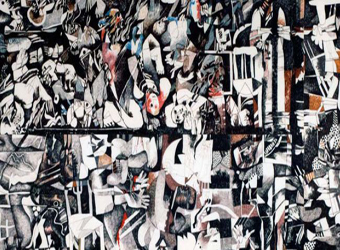London is to exhibit Iraqi artist Dia Azzawi’s Sabra Shatila which he created in response to the 1982 massacre of civilians in Palestinian refugee camps.
Described by the artist as ‘a manifesto of dismay and anger’, the epic will be displayed at Tate Modern art gallery in July.
The Sabra and Shatila massacre which was reportedly carried out by Phalange militia men with Israeli assistance and cover went on from September 16th to the 18th of 1982. Hundreds of people including women and children were either stabbed or shot to death.
“I had at that time a roll of paper and, without any preparatory sketches, the idea for the work came to me,” Azzawi said.
“I tried to visualize my previous experience of walking through this camp, with its small rooms separated by a narrow road, in the early 1970s.”
Azzawi’s work depicts the massacre through a series of fragmented scenes joined together to create a narrative.
The artist, who is known for using textual referents in his works, was also inspired by the French writer Jean Genet’s 1983 account of the massacre.
“A photograph doesn’t show the flies nor the thick white smell of death. Neither does it show you how you must jump over bodies as you walk along from one corpse to the next,” Genet says to picture the humanitarian disaster.
International sources estimated the number of Sabra and Shatila casualties to be 800; while local counts through the families of the victims say the number was more than 3000 Palestinian and Lebanese civilians killed and many missing.
Born in 1939 in Baghdad, Dia Azzawi Dia Azzawi is known as one of the pioneers of modern and politically inclined artists of his generation.
His paintings, sculptures, prints, drawings, and book art have powerful visual impact and brilliant colors.
Azzawi started his artistic career after graduating from the Institute of Fine Arts in Baghdad in 1964 and formed the New Vision Group (al-Ru’yya al-Jadidah) in 1969.
He has created many works on the plights of Palestinians such as Witness from Our Time (1972).
Azzawi’s works have been displayed in many prestigious museums and art centers such as Baghdad Museum of Modern Art, Qatar’s Arab Museum of Modern Art, the British Museum, the Victoria and Albert Museum, the Bibliotheque Nationale de France, and Washington’s Library of Congress.
